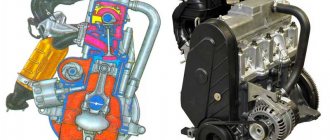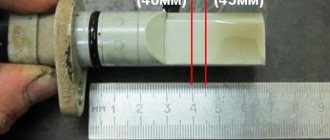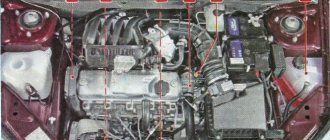Priora engine, exhaust, modifications to the cylinder head and intake are planned. How will it go in combination with these shafts? We need more or less urban ones so that there is more or less water at the bottom, and watering normally up to 7000-7500. Maybe someone rides them? how are they? Will it run noticeably better than stock?
Comments 39
Based on your wishes - It is worth limiting the rise to 10mm and the “advertising” phase to 285 degrees PKV. Something like STI-3, Nuzhdin 9.65 (263), OKB Engine 37/42.
Friend, take normal shafts right away, I ride STI 7 shafts every day, phase 314vp 308vp.
1) 13tr? ... well, not 13t.u.e! Although if you try, why not buy a used one (for 5tr)?
2) How are they driving? look at the VSKh motor LADA-GRANTA-SPORT or Kalina2-SPORT. Both have such shafts. Compare the VSKh with a Priora motor of the same configuration, but with stock shafts! Or any other city priors with easy tuning.
3) Are you asking for city ones? So they are urban...easy tuning. Not a single SPORT shaft will fall into the urban category! Not a single Stolnikovsky camshaft will fall into the CITY category. Well, perhaps an exception can be made for 8.9 Stolnikov. All the other shafts of Stolnikov are FALLING NON-CITY RAMPS! You have conflicting desires (you have both the crane and the tit... there is only one road. PHASE ROTATION)
4) Everyone who sells SHAFT will write numbers (I’m talking about the phase) that are convenient for them for their marketing and economic BENEFIT. Those. They will tell you the phase so that they sell better! Or they’ll write just to write... they have to announce something (they won’t write a slogan... “don’t ask about the phase... we don’t know the phase”).
4) Everyone measures as it seems TRUE to him! True from the technical side or from the marketing side!
So I tried on the Lada-Grant shafts... taking them out of the KALINA2-SPORT engine. I am publishing what I measured... INTAKE 9.5mm phase 293.1gr (with a gap of 0mm) phase 255.9 (with a gap of 0.15mm) phase 241gr (with a gap of 1.27mm) 0.05 inches
Release 9.0mm phase 294.6g (at 0mm) phase 260g (at 0.15mm) phase 214.8g (at gap 1.27mm) 0.05in
5) Now it’s fashionable to mention the phase according to the American method... with a gap of 0.05″ Is it fashionable? Well, here’s the phase at 0.05″ And what does it give YOU? She gives quiche in her head!
Sometimes you see posts like this. “Before the valve opens at 0.1 mm, there is practically no gas flow, so the Americans measure from such and such a value). To which I will answer you... “YOU, on an 8V engine, adjust the valve clearances not to 0.25 -0.35 (gap), but tighten the valve by 0.1mm. Try measuring your compression. Try starting the engine! After this, the quiche in your head will subside.”
The phase with a gap of 0.2-0.3mm is relevant if YOU are using a shaft for a hard cup!
The phase of the beginning of the opening and the end of the closing of the valve is a value that helps determine the degrees of advance of the opening and closing of the intake and exhaust SHAFT relative to DVN and YVN/ Knowing the profile of the SHAFT and knowing the advance angle, YOU can determine the amount of overlap in metric values (mm), well, if YOU have a measuring tool in inches, then in principle it can be determined for inches too! I wrote the previous paragraph to YOU correctly, but I think that few people understood what it was... and that’s good! The point is that YOU “don’t give a damn” what phase the GRANTA-SPORT shaft has.
The most important thing about the shaft is to know what correct overlap in mm it will have in the overlap (at the inlet and outlet). This will allow you to put it CORRECTLY. Nothing more is needed. Let's say the shaft has an overlap of more than 2.5 mm. We can say with confidence that this is no longer a city rampart. Together with a tuning receiver (usually shortened relative to the standard), you will get a failure in filling in the range of 2-3 tons! This is not a joke! This is bad for city driving. No, of course it crashes after 5t! Well, then let’s make the idle 5t.r... if this figure of 5t.r seems brutal to YOU! There are exceptions (for example, a large engine volume) and failures in filling from joyful shafts will not be observed (there are always exceptions).
Racing model? Granta Sport 2021 - review
The characteristics of the premier 2011 Lada Granta Sport, at first glance, were not impressive, although “from the start” it was developed specifically for circuit racing. Under the hood was installed a 4-cylinder turbocharged 1.6-liter engine with a torque of 300 Newtons per meter, paired with a sequential 5-speed gearbox. Even though this engine then developed “only” 235 horses, the car entered the pool of the strongest. Granta Sport produced such characteristics and proved itself in such a way that by 2014 the so-called “civilian” model was developed.
As for the appearance of the updated Granta, the designers in the 2018 modifications “redrew” the configuration of both bumpers, and for their manufacture the designers recommended not plastic, but the now very popular fiberglass - a much more practical and durable material. A small (and we especially emphasize - factory) spoiler was installed on the trunk lid, the ground clearance was reduced by 20 mm and the shape of the radiator grille was changed. By default, the “sporty” Granta is now available not only with standard “civilian” ones, but also with solid 195/50 R16 wheels.
Features, malfunctions and repair of the Lada Granta Sport engine
The basis for the creation of the first serial sports engine was the 21126 Priora engine, with a lightweight ShPG and, very importantly, with wider shafts. This engine was equipped with TMS lift camshafts 9.55/9.15, phase 288/282, modified intake, exhaust with a spider, and of course its own firmware. All this added up to a smooth engine, running from the bottom without problems and developing about 120 hp. See the measurement schedule below.
By nature, the engine up to 3000 rpm drives like a regular 126 engine, then it’s faster until the cutoff. Fuel consumption on the Grant Sport has remained virtually unchanged (with quiet operation). Otherwise, this is a Priora engine with all its shortcomings and features, the malfunctions and their causes coincide one to one, we read about them in the section “Faults 21126”.
Sporty on the outside and no less sporty on the inside
The gearshift lever and steering wheel are now covered with very high-quality leatherette, a seven-inch touch (!) display has appeared on the console, and the front windows are electric “already in the base.” By the way, the 2021 Lada Granta Sport is comparable in cost to a “non-sport” car, but in the “Lux” specification. However, even in the previous generation, the Granta Sport version was never cheap.
Lada Granta Sport 2021 – interior/front
Today's sports "civilian" Grant has a 1.6-liter engine, boosted to 120 horses and 160 Nm, against the "former" 145. This power unit was designed on the basis of a serial engine with the VAZ 21126 index - a very productive engine. Among other things, this version was equipped with brake components from AP-Racing with 200 mm 4-piston ventilated front disc brakes and 135 mm 2-piston rear disc brakes.
So-called semi-sports seats with pronounced lateral support are installed here. They have a long cushion, but are also designed in a “sporty” way.
LADA GRANTA SPORT
Specifications
| COMMON DATA | |
| Dimensions, mm: length / width / height / base | 4280 / 1700 / 1470 / 2490 |
| ground clearance, mm | 120 |
| Trunk volume, l | 520 |
| Curb / gross weight, kg | 1140 / 1540 |
| Acceleration time 0 - 100 km/h, s | 9,5 |
| Maximum speed, km/h | 198 |
| Fuel / fuel reserve, l | A95/50 |
| Fuel consumption: combined cycle, l/100 km | 7,8 |
| ENGINE | |
| Location | Front transverse |
| Configuration / number of valves | P4/16 |
| Working volume, cubic meters cm | 1596 |
| Compression ratio | 10,0 |
| Power, kW/hp | 87 / 118 at 6750 rpm. |
| Torque, Nm | 154 at 4750 rpm. |
| TRANSMISSION | |
| Type | front-wheel drive |
| Transmission | M5 |
| CHASSIS | |
| Suspension: front/rear | MacPherson / semi-independent beam |
| Steering | rack and pinion with electric booster |
| Brakes: front / rear | ventilated disc / disc |
| Tire size | 195/50R16 |
Modifications Grants
Another undoubted and indestructible trump card of this car is its maintainability. Not only and not so much in the “technical” sense, but in the “geographical” sense. Yes, absolutely everything in this car cannot be repaired “on the knee”, since any modern car has on-board electrics and some kind of electronics. But there are so many specialized car services on the world map that no matter which way you look, you’ll find a specialist in VAZ products.
That is why, probably, among the models (and their modifications) the Grant is in the lead in its simplest design. And this is absolutely no (or almost no by today’s standards) bells and whistles, no “buggy electronics”, and the motor is the most basic and simple. This is a 1.6-liter 8-valve engine with a capacity of 87 horses, coupled with a five-speed manual 5MT, in the Standard version. With such a car you can drive into the very wilds of some Altai/Siberia/Far East and you won’t be left without help (if something happens). This configuration “is missing everything,” which is why some buyers “don’t like” the modern global auto industry. Is there only one airbag and only for the driver? Well, okay! Mechanical windows? Arranges!
But the ground clearance (even on the most “poor” 13-inch wheels) is as much as 165 mm! The trunk is almost 500 liters (480 liters, to be absolutely precise). Until recently, even the vaunted Mercedes-Benz S-Klasse could not boast of a luggage compartment of such volume.
Standard equipment for all Grant models:
1. Standard 2. Standard plus 3. Classic 4. Classic start 5. Comfort 6. Comfort optima 7. Luxe 8. Luxe prestige
And here is a (not yet complete, moreover) list of additional options for the highest version called Luxe prestige, which AvtoVAZ offers:
• ESC system coupled with traction control • airbag not only for the driver, but also for the front passenger • front seat belts with pre-tensioning when the car hits an obstacle • three L-shaped headrests for the rear seats (they “know how” to hide flush with the backrest and do not interfere rear view) • alarm when the driver's seat belt is not fastened • rear seat belts - modern three-point • ISOFIX mountings - for installing child seats • safety bars in all 4 doors • brake discs - ventilated • hill start assist system • muffler made of alloy steel ( stainless steel)
And between these two trim levels (Standard and Luxe prestige) there is a whole field of diversity in filling with additional options. Compare the maximum configuration with the Standard configuration, where the car, as other buyers put it, is “empty as a drum,” and you will realize the true width of the “price range” - from 369 thousand to 594 thousand rubles.
The electrical equipment of the “most sophisticated” version uses a modern so-called Can-bus, which significantly increases the performance and reliability of all vehicle systems. The motor pistons are coated with graphite, which significantly reduces the coefficient of friction when starting a cooled motor. Plus DRLs - newfangled running lights.
Specification for bodies
But what we should dwell on in more detail is the bodies. The sedan body is honored not only by Russians, and for these reasons.
If in relatively warm Europe or the USA, where frosts occur exclusively in the strip bordering Canada, you open the trunk of a hatchback or station wagon “for a minute,” then nothing special will happen to the temperature of the cabin and to the well-being of passengers. And you try to open the trunk somewhere higher in such a body in winter at minus “at least” 20 degrees Celsius... The interior will get cold not even in minutes, but in seconds!
The second reason for our love for sedans is, of course, our constant glance at the prestigious cars of the luxury segment of the global automobile industry. Have you noticed that today very few S- and even D-class models are produced in hatchback or station wagon bodies.
All sedans! On the other hand, it should be admitted (and this is recognized by almost all car buyers today) that hatchbacks and station wagons are still... somewhat more practical than sedans. That is why AvtoVAZ offers its customers the Grant liftback - it is both almost a station wagon and almost a sedan.
From practical experience
Since this car is still from the budget segment of the global automobile industry, the buyer should be prepared for “crickets” and creaks in the sedan, and for the rattling of the shelf covering the luggage compartment of the liftback. If we take as “the norm” all these squeaks and crickets and in general the “traditionally Russian” quality of interior assembly, then car owners have practically no special complaints about the body of this car. It (the body) is quite durable, well-welded and will be worthy competition for other budget foreign cars.
Granta Sport engine characteristics
The most interesting thing is that the “sport version” is also offered - in several versions. There are two on the official resource: - 1.6-liter 16-cl. (106 hp), 5MT - called Drive Active; — 1.6-liter 16-cl. (114 hp), 5MT - called Sport - ...however, if you add the options listed above, as well as other “factory and tuning capabilities”, you can also get a whole pool of specifications.
Technical characteristics of Lada Granta Sport
Using the example of a sedan with a 1.6 liter engine 114 hp. 150 Nm and manual gearbox:
Dimensions and weight
| Length | 4280 mm |
| Width | 1700 mm |
| Height | 1470 mm |
| Wheelbase | 2490 mm |
| Front track | 1430 mm |
| Rear track | 1420 mm |
| Turning diameter | 10.6 m |
| Clearance | 150 mm |
| Curb weight | 1140 kg |
| Full mass | 1540 kg |
| Trunk volume | 520 l |
| Load capacity | 400 kg |
Plug-inless motors again
From the latest news about Grant and AvtoVAZ engines: the plant is going to return to the so-called “plug-in” engines, and the first to try on the new engine line is the restyled Granta.
What are we talking about? Not only motorists (they know this thoroughly), but also many car owners are afraid of the situation when the timing belt breaks. At this moment, the pistons “meet” the valves and destructive consequences are inevitable. Up to engine overhaul. The new engines will have different pistons with a special selection in the bottom... exactly the size of the valve heads, which will help avoid those very “critical consequences”. The official supplier of engines to the AvtoVAZ conveyor, Federal Mogul, has already mastered their production, and the changes will affect: - 8-valve VAZ-11186; — 16-valve VAZ-21126; - 16-valve VAZ-21127, - ... which are exactly installed on cars of the Granta and Kalina families. According to the plant itself, the 106-horsepower VAZ-21129 engine, intended for Vesta and XRAY, should also soon receive this same “plug-inless” version, but in the future, and the new VAZ-21179 units with 122 hp. With. (volume 1.8 liters) and VAZ 2190 Sport will “get by” for now.
What camshafts are on the sport grant?
Structurally identical motors can develop different power.
Improving performance begins with installing other spark plugs, more accurately selecting the advance angle, etc. Perform tuning yourself, “squeezing” 120 hp out of the Kalina-2 engine. – however, it will not succeed. The 120-horsepower Granta-Sport engine is built on the basis of the 21126, but has differences from it. The engine of the Granta-Sport car is no less durable and reliable than the prototype (the 21126th engine of the second Kalina). To increase power, different camshafts are installed here (with a modified cam profile). Reducing the exhaust-intake resistance is another, and final, “mechanical” change. It was possible to achieve maximum power by changing the firmware.
The developers of Granta-Sport assure that up to 3,000 rpm, the engines “behave” the same. But driving at speeds above 3,500 cannot be called economical. We conclude: installing a Granta-Sport engine in a Kalina-2 with an automatic transmission is a low-use (but even more expensive) tuning method.
What about Kalina RC?
The rally version of the “second Kalina” uses an atmospheric engine (also based on the “26th”). It features forged pistons, which are lighter than stock cast pistons. It is unlikely that you will be able to carry out such tuning on your own. Tolerances must be “maintained” even more accurately than at the factory. What is most often “forgotten” when offering to buy tuning parts.
In addition, the engine was boosted. The compression ratio has increased, power has increased (up to 155 horsepower), however, durability has significantly decreased. The period of operation of sports cars is less than 1,000 kilometers (then the car is sent for overhaul). We will leave the choice to the consumer.
Motor power function 21126
There are other tuning methods. For example, the installation of turbines, which is officially 100% prohibited.
The maximum moment of force on the Granta-Sport engine shaft is 140 N*m, “Kalina RC” is 175 N*m. All of the above suggests the following: the serial engine 21126 has potential for tuning. But the benefits of the changes are unlikely to be achieved without replacing mechanical parts (including ShPG elements).
However, a more affordable upgrade option, the so-called “chip tuning”, also makes sense. Which is true for most power units produced by VAZ. The question is what exactly needs to be achieved in the end.
Granta Sport camshafts - characteristics
The most popular camshafts are with the following characteristics: lift 9.55/9.15, phase 286/230. They are praised for their “ability” to spin even beyond 7,000 rpm. But as for “motors in general,” the most popular question is: maintainability and reliability. So, all of them (ALL engines) are extremely reliable and virtually indestructible, provided, of course, that competent and systematic routine maintenance prescribed by the manufacturer is observed. And when purchasing a used Granta, we recommend that diagnostics be carried out exclusively at a branded service center, or, in extreme cases, at an AvtoVAZ-certified enterprise.
As for the gearboxes, all three gearboxes are problem-free. The 5-speed manual transmission is a native VAZ development, and 4- and 5-speed automatic transmissions “came” to AvtoVAZ together with the Renault-Nissan alliance, and are also considered by professionals to be the standards of the global automobile industry. In particular, these boxes are found on most Renault models, starting with Logan and ending with Laguna, and in the Nissan line - this is almost its entire passenger model range from Micra to Almere.
Granta Sport has no direct competitors. For example, among the “civilian” ones one could name FAW, Geely and some other “small” “Chinese”, but they do not match in price (and in quality), and the nearest high-quality Renault Logan or (even Russian) Nissan Almera play already in a completely different league.
Answers (2)
The engine installed on the Lada Granta Sport is a serial 16 valve engine from Priora, but with some modifications.
Thus, in the sports version of the engine, camshafts with a modified cam profile are installed, which is reflected in a more complete filling of the cylinders and better purging of exhaust gases. In addition to this, the brains of the ECU were “reflashed”. Also, the intake and exhaust resistances in the engine were reduced, which overall gave an increase in power, and the engine output began to amount to 120 hp. and 154Nm of maximum torque. For comparison, the engine of the Lada Grand sedan is 106 hp and 145 Nm.
The main increase in traction occurs at high engine speeds, and up to 3000 rpm, the engine characteristics essentially remain the same. To pick up the “bottoms,” the engineers modified the gearbox (5-speed manual), where a main pair with a gear ratio of 4.3 was installed (the base had 3.7). This made it possible to accelerate to the first hundred in only 9.5 seconds and raise the maximum speed to 197 km/h in fifth gear (Grand sedan 177 km/h). In this change to the standard series of gear ratios, the fifth gear was almost straight, rather than overdrive, and the fourth turned from direct to intermediate. At the same time, fuel consumption was 7.8 liters per 100 km. Gasoline AI-95.
Video – 2018 Lada Granta Sport POV Test Drive
Dimensions
Chassis
Fuel
Engine
The larger the engine capacity, the more powerful the car, and, as a rule, the larger it is. There is no point in installing a small-capacity engine on a large car, the engine simply cannot cope with its weight, and the opposite is also pointless - installing a large engine in a light car. Therefore, manufacturers are trying to select a motor. to the price of the car. The more expensive and prestigious the model, the larger the engine capacity and the more powerful it is. Budget versions rarely boast a cubic capacity of more than two liters.
Engine displacement is expressed in cubic centimeters or liters. Whichever is more convenient for you.
The engine capacity of the Lada Granta Sport is 1.6 liters.
Engine power of Lada Granta Sport is from 106 to 118 hp.
Recommendations
Comments 39
Based on your wishes - It is worth limiting the rise to 10mm and the “advertising” phase to 285 degrees PKV. Something like STI-3, Nuzhdin 9.65 (263), OKB Engine 37/42.
Friend, take normal shafts right away, I ride STI 7 shafts every day, phase 314vp 308vp.
1) 13tr? ... well, not 13t.u.e! Although if you try, why not buy a used one (for 5tr)?
2) How are they driving? look at the VSKh motor LADA-GRANTA-SPORT or Kalina2-SPORT. Both have such shafts. Compare the VSKh with a Priora motor of the same configuration, but with stock shafts! Or any other city priors with easy tuning.
3) Are you asking for city ones? So they are urban...easy tuning. Not a single SPORT shaft will fall into the urban category! Not a single Stolnikovsky camshaft will fall into the CITY category. Well, perhaps an exception can be made for 8.9 Stolnikov. All the other shafts of Stolnikov are FALLING NON-CITY RAMPS! You have conflicting desires (you have both the crane and the tit... there is only one road. PHASE ROTATION)
4) Everyone who sells SHAFT will write numbers (I’m talking about the phase) that are convenient for them for their marketing and economic BENEFIT. Those. They will tell you the phase so that they sell better! Or they’ll write just to write... they have to announce something (they won’t write a slogan... “don’t ask about the phase... we don’t know the phase”).











